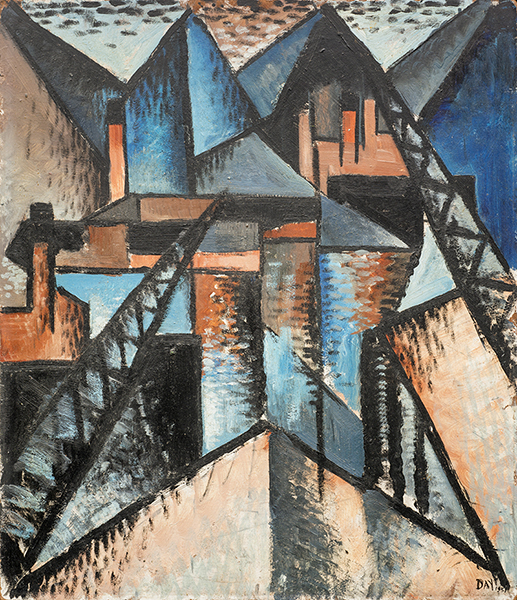19 January 2016
Julia Waite
Article Detail

Melvin Day
Boats in Wellington Harbour 1951
Auckland Art Gallery, Toi o Tāmaki, purchased 2001
Melvin Day lived near the Seatoun foreshore, in an old colonial-style villa tucked beneath the hills. In his small painting studio, just off the kitchen, lay a collection of works from his more than 70-year career. Among these were naturalistic still lifes completed in the Elam house-style when Day was a boy, and figurative watercolours informed by Lois White’s social-realism which reflect his early training. The large, more abstract paintings from the late 1950s and early 60s in this personal collection reveal his ambitions to move beyond naturalistic realism. And on the surface of later tachiste-inspired works Day had combined entire metal tubes of paint and other detritus with thick mixtures of paint and white lead. An old swing-tag hung from the corner of one of his heavily impastoed red abstractions, Red Cliffs, 1961. It read ‘Young Commonwealth Painters: White Chapel Gallery’ in fine black ink. The painting was selected for the exhibition by the then director of Auckland City Art Gallery, Englishman Peter Tomory, and art patron Charles Brasch.
Day was working during a time when the bulk of our directors and art school educators came from England. He was outwardly focused and like many of his generation looked to Europe as art’s cultural heart. In 1963, he began studies at the Courtauld Institute of Art in London where he was taught by Cubist scholar John Richardson. Day would go on to critique his own early attempts at Cubism, produced at the edge of the periphery in Rotorua, at the same time as he quietly revelled in the energy and sense of discovery in his attempts to understand Cubist principles and techniques.
Invited in 2015 to be part of Auckland Art Gallery’s Freedom and Structure: Cubism and New Zealand Art 1930–1960 exhibition, Day described himself as the ‘last man standing’. In the 1940s he forged important friendships with senior painters John Weeks and Dr Wilfred Stanley Wallis, whose work is also presented in the exhibition. These creative associations took him beyond the stylised naturalism of the Elam school into new and relatively uncharted waters. Day’s experimentation with Cubism in the late 1940s and early 50s was renegade in time and place. His starkly geometricised landscapes of the thermal area of Waiotapu, and the dynamically charged Picassoesque still lifes of fractured fruit and spiky flowers, represent some of the earliest examples of a Cubist-inspired practice in New Zealand. Day and Wallis transformed their painting together; working in their make-shift studio at the Queen Elizabeth Hospital in Rotorua they moved beyond a mimetic representation of optical experience towards the development of their own abstract visual languages informed by a Cubist reappraisal of form and space.
Last year Day chose to gift a number of his important paintings to Auckland Art Gallery Toi o Tāmaki. These form part of a significant legacy he initiated which includes Mary Chamot’s own gifting of Russian modernist paintings by Natalia Goncharova to the then National Art Gallery (now Museum of New Zealand Te Papa Tongarewa), a gift secured by Day, who was then the Gallery’s director. He was also closely involved in acquiring and protecting Rita Angus’ estate collection for long loan at Te Papa.
Born in the early 1920s, Day’s life experiences and views on art were shaped by his early training at the Elam school of art in Auckland; his time spent in Europe in the 1960s at the Courtauld; and his professional knowledge gained as director of the National Art Gallery, and later as the Government Art Historian. He devoted his career to exploring different artistic movements and this spirit of scholarly adventure informed his own artistic experimentation. Day’s vision was not anchored to a particular time or place; he gave his imagination and creative skills free reign to explore the theories and techniques of the past, including, and perhaps most notably, the work of Early Renaissance painter Paolo Uccello.
It was a privilege to work closely with Melvin Day on the development of Freedom and Structure. I will miss our conversations, and his lively and generous mind.
